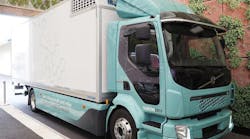Today we have extremely clean diesel engines operating. In fact, 43% of the nation’s trucks are now powered by post-2010 emissions technology, according to a report from Diesel Technology Forum. So why then do we need commercial battery electric vehicles? I asked that question of a panel of industry experts during a recent webinar we hosted.
James O’Leary, vice president, fleet services at NFI Industries, said, “The need for sustainable transport has been there for awhile. Today is a perfect storm because demand is matching where technology is.”
Alexander Voets, eMobility product and sales strategy manager, Daimler Trucks North America, concurred saying “environmental sustainability is a big, big driver.” He added that although the initial purchase price of a commercial battery electric vehicle (CBEV) may be higher, the running costs are lower.
Our conversation next moved to talking about the duty cycles that are best suited for CBEVs. According to Amanda Phillips, general manager, OEM Sales, Meritor, school buses, pickup and delivery operations, drayage trucks and yard spotters are well suited for CBEVs because they operate in less than a 150-mile range and have significant dwell time which allows them to recharged easily.
While currently there is a certain coolness factor when it comes to CBEVs, one thing that is less cool is the charging aspect. Justin Bardin, senior project manager, operations eMobility, customer programs and services, Southern California Edison, said the utility is talking to customers “early and often in an attempt to bring total cost of ownership down.” He said the utility is working with customers on plans, power levels and the billing side. “We are trying to help with unique time of use, charging when cost of electricity is less and waiving demand charges.”
Given the limited use of CBEVs charging has not been a real issue, but fleets need to look at scaling the infrastructure if they plan to increase the percentage of CBEVs in their operation. “We think about this a lot. We look at where fleets are, how they plan to grow and circuit capacity.” Bardin said.
NFI’s O’Leary said nothing they have done to date with CBEVs is complex as they only have 10 trucks, but they are thinking about the future. “We have to ask ourselves do we own [a particular] facility so we can make all the decisions about what to do. Size determines what needs to be upgraded. For us so far it has just been transformers.” But he acknowledged that will change if NFI adds more CBEVs. And even the process of getting permits, signing contracts and getting chargers can take nearly a year from when you embark on the project until it is operational, so planning early is essential.
We concluded the webinar asking our panelists for their predictions on where CBEVs would be in five years and in 20 years.
Here is some of what they said:
- “Supply will go up and demand go up; there is no doubt about that. To accelerate adoption the price of batteries will have to come down and infrastructure development will have to increase,” Voets said.
- Phillips also believes in five years there will be increased growth in vehicle production and demand for battery electric vehicles. “In 20 years, the current applications [for CBEVs] will be seeing high use and we will see some growth in CBEVs in Class 8. There is a place in the market for electric vehicles.”
- Bardin said his five-year goal is to see 900 new sites and 9,000 CBEVs on the road. “And in 20 years I want to see silent and clean electric vehicles on the 710 (Interstate 710 in California) and more advancements in both vehicles and the grid.”
- O’Leary said that the industry is changing, and average length of haul is decreasing. “The use case for CBEVs becomes more viable at these shorter lengths. In 2025 25% to 50% of our fleet will be electric based on the use case.”
Three things need to happen for CBEVs to grow:
- The TCO has to get even when compared to diesel
- Weight, reliability and range questions have to be answered
- Charging infrastructure needs to be developed
- Perhaps Voets summed up the future of CBEVs best “There is only one way for CBEVs to go and that is up.”



